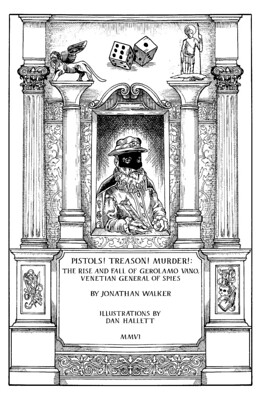Monday, February 15, 2010
Pistols! Treason! Murder!: Review from Library Journal
Strip away the whiz bangs here—comic-strip sequences, chapters in which the author and friends meet in cafés to talk over their obsession with the past, time-sequence photographs of a flintlock firing—and this is first-rate history, just of a different kind. The flashy stuff works here, with an effect similar to that of Michael Lesy's groundbreaking 1973 Wisconsin Death Trip, where Lesy's pictorial editing forced the reader to look at events a second time, catching nuances that might otherwise have been missed. Walker (research fellow, Univ. of Sydney) describes an incident of spying in 1622 Venice. A master spy, Gerolamo Vano, presents evidence that leads to a Venetian nobleman's hanging on charges of espionage. Five months later, Vano himself is executed for falsifying evidence, and the nobleman is absolved posthumously. But this book isn't just about Vano, about whose machinations the evidence is spotty. It's as much or more a reflection on how one approaches the historical record: how to exhume a coherent narrative from uneven, desultory, and usually self-serving reports. VERDICT This book will infuriate as many scholars as it excites, but it is original, well written, and good. It should intrigue anyone who likes reading history.—David Keymer, Modesto, CA
Thursday, February 4, 2010
Pistols! Treason! Murder!: The Illustrations

Above is a slide show of selected illustrations from my first book, Pistols! Treason! Murder! These illustrations were a late addition to the manuscript. They were created by Dan Hallett, in a rush at the end of 2005, concurrently with my final edits on the text. At this point, our collaboration was still rather haphazard, and my instructions to Dan consisted primarily of scribbled notes and doodles on the backs of hundreds of pages photocopied from early modern source books.
Dan and I had first met in Cambridge in 2001, and we had worked together there to create four sample comic strip pages as an experiment. Subsequently, I had moved to Australia and Dan had moved to Spain, so when my editor at Melbourne University Press, Elisa Berg, asked if we could add more illustrations like the sample pages, I said yes, without actually being sure what that would entail.
In the event, Dan and I were able to renew our collaboration entirely by e-mail, and in a much more effective way than before, resulting not only in a new set of illustrations, all in the style of seventeenth-century woodcuts, but subsequently in an even more ambitious project: that is, our illuminated novel, Five Wounds (on which, more anon).
Wednesday, February 3, 2010
Pistols! Treason! Murder! at Rorotoko
Above: The Wounds of Giulio Cazzari, created by Dan Hallett.
This illustration accompanies the title chapter of Pistols! Treason! Murder! It depicts in allegorical form the assassination of Giulio Cazzari, one of Vano’s numerous victims.Vano’s costume here is taken in part from that of the figure of “The Spy” in Cesare Ripa’s Iconologia, a ubiquitous visual source book of the period. Note the cloak of eyes and ears, and the winged boots of Hermes, messenger of the gods, who was also patron of “revelation, commerce, communication and thieving” (Vano’s activities fell under all four categories).
The cup is filled with ink, but obviously alludes to the Holy Grail, while the imagery as a whole also suggests the iconography of the wounds and sacred heart of Christ. However, in the context of the book, there is a more explicit reference to a passage from an earlier chapter, “Idiolect,” in which Vano’s words, read aloud, “taste like red wine—or, to be more precise, bad red wine: acidic, furring the tongue, lips and teeth; intoxicating, yet also prone to induce sore eyes and jabbing headaches. The more of them you speak, the more they numb the mouth and brain, and induce slurring.”
Intoxication as a response to Vano’s words is a recurrent theme in the book, underlined elsewhere by another image in which I am shown drinking from the same cup into which Vano dips his pen here.
In the image above, intoxication is further associated with a kind of knowledge based on vicarious participation in historical events through exemplary re-enactment, that is with the stigmata, and with holy communion, in which a Christian devotee respectively receives the wounds of Christ, or ingests the blood of Christ. But here the sacred meaning is violently profaned. The secular grail that Vano holds aloft is therefore the elusive, unattainable goal of every historian’s quest: direct, unmediated access to the past.
Finally, the disassembled corpse of Giulio Cazzari, the victim whose remains lie within the heart at the image’s apex, also alludes to the fragmentary nature of the sources recounting his death, which cannot be stitched together into a single, coherent narrative.
To be absolutely clear, this image makes no claim to be a literal depiction of anything. Although it is composed of elements adapted from early modern sources, I have no idea what Vano or Cazzari looked like or wore. And while Cazzari certainly was assassinated as a result of Vano’s reports on his activities, his dead body was not in fact dismembered. This image is therefore a kind of diagram, one mapping arguments and elaborating subtexts rather than describing events.
None of the ideas outlined in the discussion above are expressed directly in the text of the book. Such explanation would be redundant: the argument is all there in the illustration itself, and in its implied relation to other elements of the presentation, both visual and linguistic. So another of my arguments is, in effect, that we should take images seriously as independent vehicles for complex and abstract ideas.
[There will be more on the illustrations for Pistols! Treason! Murder! in future posts ...]




